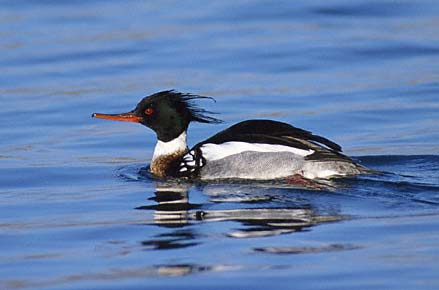One characteristic of grebes is that they dive to feed, rather than dabble, like mallards. So if you’re watching it, it might pop under water for a minute or so and then pop back up somewhere else.
Were you too far away to see color or more than a silhouette? Northern Shovelers might work at enough of a distance ( white around necks, extending in two strips along the upper-back and underwing when flying, long-ass beaks that might look pointy at the right angle ), but closer they’re pretty distinctive and definitely don’t have an egret-like bill.
http://www.pbase.com/jody_melanson/image/58422593
- Tamerlane
From the description, your duck is almost certainly a Red-breasted Merganser.
Males:
Females
http://www.southwestbirders.com/SD_20020213/red-breasted%20merganser_001_2s.jpg
Regarding the behavior you mentioned, here are some merganser courtship displays:
http://content.ornith.cornell.edu/UEWebApp/images/fig2_1301.gif
As for your other bird, if it’s not a Pied-billed Grebe my guess is a Horned Grebe in winter plumage.
More images:
http://www.utahbirds.org/birdsofutah/BirdsD-K/HornedGrebe2.htm
The bill is more duck-like than that of a Pied-billed Grebe.
A Red-necked Grebe is also possible, but is bigger and less “duckling-like”.
Just got back from my run, and saw duck 2 again. Think it probably is a grebe, but still not sure about the type.
Was running with a different guy and blathering on about my “birding” frustrations. Saw 2 brown birds a ways out on the lake, and noticed that they dove instead of dabbled. So I thought “Aha! Grebe behavior! Too bad they are too far out to ID.” When up popped a 3d no more than 20-30 feet away. Took a good long look at it and…
STILL CAN’T POSITIVELY ID IT! The features I noticed most were that it seemed to be lighter tan on the back of its head and down the back of its neck, as well as at its tail. Also, from the side it seemed as tho its belly was somewhat lighter than the dull brown of its wings.
If it were a horned grebe, I think I would have noticed those demonic red eyes.
How much of the time are birders able to say “That’s definitely species X” instead of simply saying, “Well, it doesn’t look exactly like the pictures of X, but that’s the only thing it CAN be”?
Eye color can be very difficult to make out without binoculars.
Depends on the birder, on the species, and on the viewing conditions.
Given a good close view, in good light, of a species I know well, I can probably identify 99.9% or better of individuals. However, some species are just so similar that individuals may not be identifiable to species in the field, especially if not calling. Given bad viewing conditions, the percentage positively identified will fall off a lot, even for expert birders. A good birder knows that not all birds can be identified.
On last year’s Bronx Christmas count, my party had a bird we identified as a Pacific Loon, which is very rare in the area. (I think ours was the first record since 1935 on our count.) It was moderately distant, but we got some decent views in a scope, good enough that I felt confident enough to make the call. But some birds can be very tough.
Every once and a while I will see a “mystery bird.” Sometimes this may be a bird in an odd plumage (melanistic or albinistic), some weird stage of molt, or a hybrid. Some birds are just not identifiable, even in the hand.
Colibri - I know I’m not the only person who really appreciates what you bring to these boards.
If you ever find yourself passing through Chicago, I’d appreciate the opportunity to buy you a beer - or maybe just take a trip to the magic hedge.
Let this be a lesson to you - never EVER go anywhere with out binoculars. You may look like a dork, but you will see birds much more clearly!
Thanks for the kind words. If I ever am passing through Chicago I may take you up on the beer.
Never to let a thing die, we saw a pair of the “mergansers” again today, somewhat closer. i was able to convince myself that the male was reddish brown on his breast.
They both flew away from us when we approached. Both male and female had white patches on the tops of their wings, right where they met the body. Does that sound right?
here is an ancient thread with a similar question. Maybe yours are the same as these; hybrid or variant mallards
Yes, that’s exactly right for Red-breasted Mergansers. I have little doubt that that’s what they were.
I’m doing a little happy dance right now!
Can’t wait to go running over lunchtime - yeasterday we saw some other divers we didn’t recognize. I’m guessing they might have been coots, but I wanna get a better look.


